To read the full report, please download the PDF above.
Middle East Daily
SOOJIN KIM
Research Analyst
DIFC Branch – Dubai
T: +44(4)387 5031
E: soojin.kim@ae.mufg.jp
MUFG Bank, Ltd. and MUFG Securities plc
A member of MUFG, a global financial group
Middle East Daily
OPEC+ output hike sparks supply concerns amid demand uncertainty. Oil prices slipped after OPEC+ agreed to increase production by 547,000b/d staring in September, raising fears of oversupply at a time when the global demand outlook is clouded by trade tensions and slowing economic indicators. Brent crude hovered near USD69b and WTI near USD67/b, following last week’s losses triggered by weaker than expected US jobs data. The September hike completes the reversal of previous cuts by key producers like Saudi Arabia and Russia, signalling a push to reclaim market share. However, market sentiment remains cautious, with traders watching for possible US sanctions targeting Russian oil exports, particularly to India, amid efforts to pressure Russia over Ukraine. While OPEC+ policy remains flexible, uncertainty over geopolitics, US economic momentum, and Russian flows continues.
Gold holds ground after surge on weak jobs data and trade tariffs. Gold held steady after posting its biggest gain in two months on 1 August, as investors assessed the impact of weak US employment data on the economy and the Fed’s interest rate trajectory. Gold hovered around USD3,360/oz, following a 2.2% surge in the prior session, while stocks declined/ the sharp increase in gold was largely driven by two key developments. A significant slowdown in US job growth that boosted expectations of rate cuts and President Trump’s introduction of some of the most severe trade tariffs since 1930s. Looking ahead, gold prices are likely to remain supported in the near term as market participants increasingly price in rate cuts and seek safe-haven assets amid rising economic uncertainty.
MIDDLE EAST - CREDIT TRADING
End of day comment – 01 August 2025. Tariff day overnight was greeted by a good dose of macro risk off in the morning. Higher UST yields to start kept spread moves in check though, but market felt heavy with ETF outflows. Post NFP and the subsequent UST rally spreads started to widen in line with the macro weakness in equities and credit indices. Flows were more balanced though in the afternoon as yield buying in some assets resumed. On balance IG is going out 4/5bp wider in long end bonds, especially QATAR had offers in bonds on higher cash prices following the selling we saw yesterday. With the 20bp move in front end UST, spreads in the shorter end of IG curves closed around 10bp wider. The jury is still out if the market and accounts will buy into short end bonds at lower yield levels. However overall it feels like today the macro moves have taken the market out of its summer lull. If UST yield break lower from here we should see wider spreads, especially if based on economic fears.
MIDDLE EAST - MACRO / MARKETS
Lebanon passes long-awaited banking restructuring law amid IMF pressure. Lebanon’s parliament has approved a long-delayed banking sector restricting law, a key step toward securing international aid and reforming the country’s shattered financial system following the 2019 economic collapse. The legislation outlines a framework for dealing with defaulted banks and establishes a commission to oversee the sector’s overhaul. Though considered a milestone by the IMF, the law postpones the contentious issue of how to apportion the estimated USD70bn in financial losses, a decision left for a separate and still pending financial gap bill. The law’s passage came after months of wrangling among the central bank, finance ministry, and lawmakers, particularly over the extent of the central bank’s influence within the oversight body. While the final structure reflects the central bank governor’s proposal and gives it a significant role, critics warn it risks repeating past mistakes by consolidating too much power in one institution. Nonetheless, the law marks the closest Lebanon has come to meeting the IMF’s conditions and comes as donors press Lebanon to implement reforms to unlock post-war reconstruction funding.
Saudi budget deficit narrows in Q2 as revenues recover despite oil headwinds. Saudi Arabia’s budget deficit narrowed to SAR34.5bn (USD9.2bn) in Q2 2025, marking a 41.1% q/q decline, as both oil and non-oil revenues rebounded, according to the Finance Ministry. Total revenues rose 14.4% q/q to SAR301.6bn (USD80.4bn), with oil income up 1.3% to SAR151.7bn (USD40.4bn) and non-oil revenues reaching SAR149.9bn (USD39.9bn), underscoring the Kingdom’s progress on economic diversification under Vision 2030. In May, oil exports hit a three-month high, with the OPEC+ alliance gradually reversing production cuts, although lower crude prices continue to weigh on fiscal performance. Despite posting a wider deficit of USD15.65bn in Q1, Saudi Arabia is projected to record a USD27bn fiscal gap this year. The IMF recently upgraded its 2025 GDP growth forecast to 3.5%, citing stronger demand for state-led projects and the phasing out of OPEC+ output cuts.

